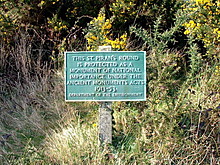|
|
|
|
Piran's RoundHillfort
|
||||||||||||||||||||||||
|
|
|
Images (click to view fullsize) |
|








|
Fieldnotes |
|
|
Visited 19.4.12 My 900th field note! - that’s a lot of writing (and walking!) Parking is available right next to the site. The pink house mentioned in previous field notes is now beige! The information board is interesting and has good photos. I know this is listed as a ‘Hillfort’ but it gives a good idea of how Henges must have looked in their prime. For some reason it reminded me of a mini version of the Roman amphitheatre in Caerleon. The surrounding ditch is about 1m deep and the bank about 3m high. I really liked this place and would heartily recommend a visit when in the area. Watch the B3285 though – it’s a busy one! |
Posted by CARL 9th May 2012ce |
|
St.Piran's Round - 2nd October 2003 Although it's not signposted it is relatively easy to find 1.2km along the B3285 from Goonhavern (towards Perranporth), on the north side of the road, just off a small lane opposite a pink house. You can park a car discreetly on the side of the lane, just off the main road. There is open access to the land. There is a stile into the enclosure where the earthwork stands and a flagstone entrance into the interior. A small sign gives the following statement, "This St.Piran's Round is protected as a monument of national importance under the Ancient Monuments Acts 1913-53: Department of the Environment". The earthwork is 'perfect'. Well kept, a perfect circle, with two opposite entrances, equal height banks, and a decent (if overgrown) ditch on the outside. Birds fluttered and it was all so idyllic, almost too idyllic! The ladle shaped depression is way cool. I can just imagine it being used in the medieval miracle plays. This post appears as part of the weblog entry Kernow again - Part 2 - Land of the Giants
|
 Posted by pure joy
Posted by pure joy7th October 2003ce Edited 7th October 2003ce |
|
Another of the sites you wouldn't know about unless you flew over it. Just of the roadside between Goonhavern and Perranporth. Don't look for any sign posts though (You won't find any) |
Posted by phil 16th March 2002ce |
Folklore |
|
St Piran has several stoney connections - for one, he travelled to Cornwall from Ireland on one.On a boisterous day, a crowd of the lawless Irish assembled on the brow of a beetling cliff, with Piran in chains. By great labour they had rolled a huge millstone to the top of the hill, and Piran was chained to it. At a signal from one of the kings, the stone and the saint were rolled-to the edge of and suddenly over, the cliff intd the Atlantic. The winds were blowing tempestuously, the heavens were dark with clouds, and the waves white with crested foam. No sooner was Piran and the millstone launched into space, than the sun shone out brightly, casting the full lustre of its beams on the holy man, who sat tranquilly on the descending stone. The winds died away, and the waves became smooth as a mirror. The moment the millstone touched the water, hundreds were converted to Christianity who saw this miracle. St Piran floated on safely to Cornwall; he landed on the 5th of March on the sands which bear his name. He lived amongst the Cornish men until he attained the age of 206 years.Another stoney story explains the origins of the black and white Cornish flag: St Piran, or St Perran, leading his lonely life on the plains which now bear his name, devoted himself to the study of the objects which presented themselves to his notice. The good saint decorated the altar in his church with the choicest flowers, and his cell was adorned with the crystals which he could collect from the neighbouring rocks. In his wanderings on the sea-shore, St Perran could not but observe the numerous mineral, veins running through the slate-rocks forming the beautiful cliffs on this coast. Examples of every kind he collected; and on one occasion, when preparing his humble meal, a heavy black stone was employed to form a pan of the fireplace. The fire was more intense than usual, and a stream of beautiful white metal flowed out of the fire. Great was the joy of the saint; he perceived that God, in His goodness, had discovered to him something which would be useful to man.From Robert Hunt's "Popular Romances of the West of England", now online at the excellent Sacred Texts Archive: http://www.sacred-texts.com/neu/eng/prwe/index.htm |
 Posted by Rhiannon
Posted by Rhiannon2nd January 2007ce |
Miscellaneous |
|
| The round apparently still stages the occasional miracle play, and the Cornish Gorsedd has been held there three times. |
 Posted by pure joy
Posted by pure joy9th October 2003ce |
|
Apparently it was originally an Iron Age/Romano-British enclosed farmstead it was converted in the medieval period to a Playing Place where miracle plays were performed. The depression in the middle (The Devil's Spoon) was the place where the Devil sprang from during the performances. There are several "Playing places" in Cornwall. In Cornish they are called "plen-an-gwarry" |
Posted by phil 16th March 2002ce Edited 24th March 2013ce |
Links |
|
St. Piran TrustThe St Piran Trust is "a non-profit-making charitable Trust which is committed to the development, protection and good administration of the historic sites on Gear Sands connected with St Piran" - and that includes looking after St Perran's Round. This page contains lots of information on the site's use over the last few centuries. |
 Posted by Rhiannon
Posted by Rhiannon2nd January 2007ce |

